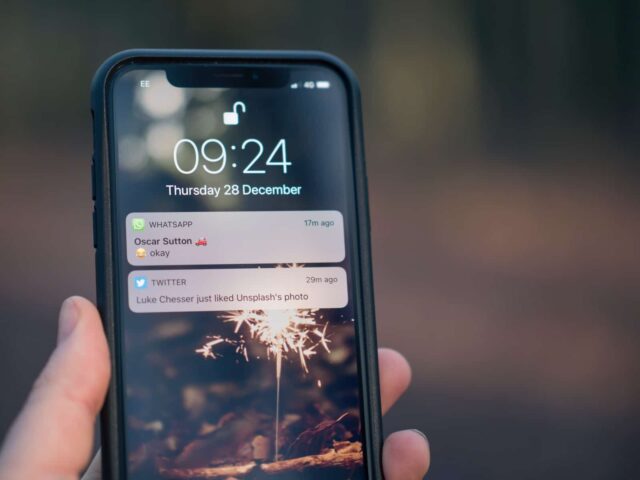Before we begin with the primary content for our blog, let’s Start With Understanding The Mobile Push Notifications, First.
Mobile push notifications are short messages or alerts sent from mobile apps to the users’ devices, such as smartphones or tablets. These notifications are designed to engage, inform, or prompt action from app users, even when the app is not actively in use. Push notifications are a powerful tool for app developers and marketers to keep users connected and informed, increase user engagement, drive app usage, and improve overall user experience.
They appear on the device’s lock screen, notification center, or status bar, depending on the platform and user settings.
Types Of Mobile Push Notifications:
Mobile push notifications are an essential tool for engaging users and driving them back to mobile apps. There are several types of mobile push notifications, each serving different purposes and use cases. Here are the most common types:
- Informational Notifications:
These notifications provide users with relevant and timely information. They can include updates on app features, new content, product launches, news, or any other announcements that users might find useful. Informational notifications aim to keep users informed and engaged with the app.
- Promotional Notifications:
Promotional notifications are sent to promote special offers, discounts, sales, or personalized deals to encourage users to make a purchase or take advantage of specific app-related incentives. These notifications can significantly impact user retention and conversion rates. These conversions then can be tracked using a dedicated Mobile Marketing platform for better results.
- Personalized Recommendations:
These notifications leverage user behavior and preferences to deliver personalized content recommendations. By analyzing user interactions and historical data, apps can send push notifications suggesting products, articles, or content that align with the user’s interests, increasing engagement and user satisfaction.
- Abandoned Cart Notifications:
Abandoned cart notifications are triggered when a user adds items to their shopping cart but leaves without completing the purchase. These notifications serve as reminders and incentives, encouraging users to return and complete their purchases.
- Geolocation-Based Notifications:
Using geolocation technology, apps can send push notifications to users when they enter a specific geographic area or when they are near a physical store or location related to the app’s services. Geolocation-based notifications can offer location-specific deals, information, or incentives.
- Event Reminders:
Event reminder notifications are used to remind users about upcoming events, appointments, or scheduled activities. This type of notification is commonly used by event-based or productivity apps to ensure users don’t miss important dates.
- Social Interaction Notifications:
Social apps use these notifications to inform users about friend requests, likes, comments, or messages. Social interaction notifications encourage users to return to the app and engage with their network.
- Breaking News or Urgent Alerts:
News and media apps often send push notifications for breaking news or urgent alerts to keep users updated on critical events or situations.
- App Update Notifications:
App update notifications inform users about new versions of the app, bug fixes, feature enhancements, or improvements. These notifications encourage users to update to the latest version for the best app experience.
- Onboarding and User Engagement:
During onboarding, apps can send push notifications to guide users through initial setup and introduce key features. User engagement notifications can offer tips, tricks, or helpful information to enhance the user experience and encourage active app usage.
Characteristics Of Mobile Push Notifications:
Here are some key characteristics and features of mobile push notifications:
- Short and Concise: Push notifications typically consist of a short and concise message, limited to a certain number of characters, to capture users’ attention quickly.
- Visual Elements: Push notifications can include visual elements such as app icons, images, or emojis to make them more appealing and recognizable to users.
- Call-to-Action: Many push notifications include a call-to-action (CTA) button or link that directs users to a specific page within the app, a website, or a landing page, encouraging them to take a particular action.
- Personalization: Apps can personalize push notifications by using user data and behavior to deliver more relevant and targeted messages, increasing their effectiveness.
- Opt-In and Opt-Out: To receive push notifications, users must opt-in to allow the app to send them. Additionally, users have the option to opt-out or manage their notification preferences through device settings.
- Silent Notifications: Some platforms support silent notifications, which do not display a visible alert but can trigger actions in the background, allowing apps to perform specific tasks without interrupting the user.
- Deep Linking: Deep linking enables push notifications to take users directly to specific content or sections within the app, enhancing the user experience by reducing unnecessary navigation.
- Rich Media: Modern push notifications can support rich media, including images, videos, and interactive elements, creating more engaging and immersive user experiences.
- Scheduled and Triggered Notifications: Push notifications can be scheduled to be sent at a specific time or triggered based on certain events or user actions, such as completing a level in a game or abandoning a shopping cart.
- Geolocation: Apps can use geolocation data to send location-based push notifications, providing users with relevant information based on their current location.
Mobile push notifications have become an integral part of mobile app marketing and user engagement strategies. When used thoughtfully and sparingly, they can significantly impact user retention, app usage, and overall app success. However, it’s essential to strike the right balance to avoid overwhelming users and potentially leading to them disabling push notifications for the app.








